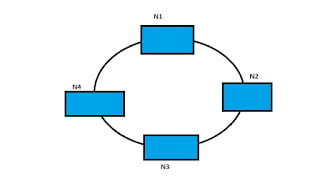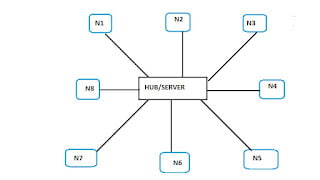Different Network Topologies- A topologies defines the physical and logical arrangement of different workstation with cable in a network . There are several topologies used in network struc
BUS TOPOLOGY:
It is the simple topology of LAN. Here multipoint configuration is used. Several nodes are connected to a cable known as backbone cable. Here only one node can send data to other in the backbone. Bus topology was commonly used in early Ethernet networks, where devices were connected using coaxial cable.

Advantages :-
- Very easy to install new node and delete a node.
- Less cable needed results lower cost.
- As the BUS topology network is simple and small in size ,there is no chance of data loss.
- If one node gets defected it will not affect other.
Disadvantages :-
- If the number of nodes increases the transmission rate will go down.
- If the backbone cable breaks down, then the whole transmission system will stop working.
- We need two terminators data can flow back and forth to the backbone.
- As only one node is capable of Data transfer at a time, data transmission rate is low.
2 .RING TOPOLOGY:
In this topology each device has point to point link with neighboring two devices. It forms a ring shape that is why this topology is known as ring topology. The main characteristics of ring topology is
The data sent by one node received by each node. We use duplex mode for ring topology. Each node uses a token for sending and receiving a message. Ring topology may be rectangle, polygonal in shape.

Advantages :-
- Easy to install and less cost
- Here OFC is used for data transfer, so data transfer rate is higher than bus topology.
- It avoid network traffic.
Disadvantages :-
- if one node is erroneous the whole network system will be affected.
- To add new node or delete node increase complexity.
- Error in one node affect the another node.
- Here we need more complex hardware than bus topology.
STAR TOPOLOGY:
In star topology a central computer system is used known as hub. With it other nodes are connected. The whole data transfer is controlled by the hub. The computers are in star shape that is why this topology is known as star topology. When a node send a message it first reaches to hub and then it is send to the destination node according to its address matching.

Advantages :-
- If one node is error, it does not affect other networks or nodes. Cable replacement is easiest in this topology.
- To add a node or delete a node is easier.
- Data transmission speed is higher than other.
- The data transmission is fully controlled by the hub.
Disadvantages :-
- This topology is mostly dependent on hub. If the hub becomes faulty then the whole system will be corrupted.
- It needs extra cable which increase the installation cost.
- The number of node in this topology is dependent on the number of ports of the hub.
- Low data transfer rates in the wireless system.
- It is very costly.
MESS TOPOLOGY:
IN mesh topology every device has a dedicated point to point link with other devices. If there are n devices then we need links. In mess topology there are several paths for data transfer.

Advantages :-
- There is no chance of traffic congestion.
- If one link has some problem or one node has some fault it does not effect as there are several paths.
- Data transfer rate is highest.
- This topology is more secure than other topologies as there are direct link between nodes.
Disadvantages :-
- we need more cable which increase more installation cost.
- Explanation of network is quite difficult.
- To remove a node and then insert a node is difficult.
TREE TOPOLOGY:
In this topology the nodes are connected as a shape of inverted tree. Here in the upper level the main server is with that the other branch node are connected in second level. here also the message is sent by a node reaches to other node of that level. in tree topology there can be only one connection between any two connected nodes.

Advantages:-
- It can be widely extendable.
- To remove a node or to add a node is much easier.
- We can add as many node as our wish.
- A tree topology network can be managed and maintain easily.
- It is best suitable for small size organization.
Disadvantages:-
- The main disadvantage of this topology is if the main server is off the network system will be stop.
- If the node is far away from the main server ,data have to travel more node which decrease speed .
- Unlike others this topology is more complex.
- It might be tough to keep a network up and running where multiple nodes are there.
- Installation of tree topology is might be difficult because it uses star and bus configuration.
Hybrid topology:
Hybrid topology is a type of network topology in which two or more different topologies are connected to establish a network. The network type could be bus, star, ring , mesh etc.
Advantages:
- Since this topology is made by two or more topologies , advantages multiplies.
- Hybrid topology is a better option in large geographical area.




